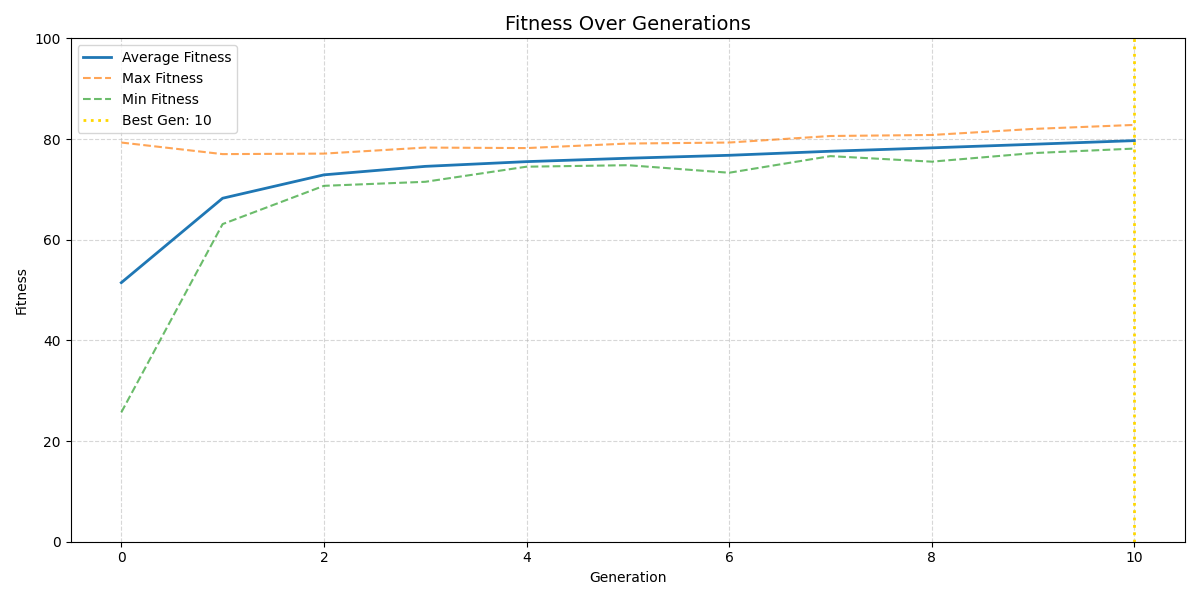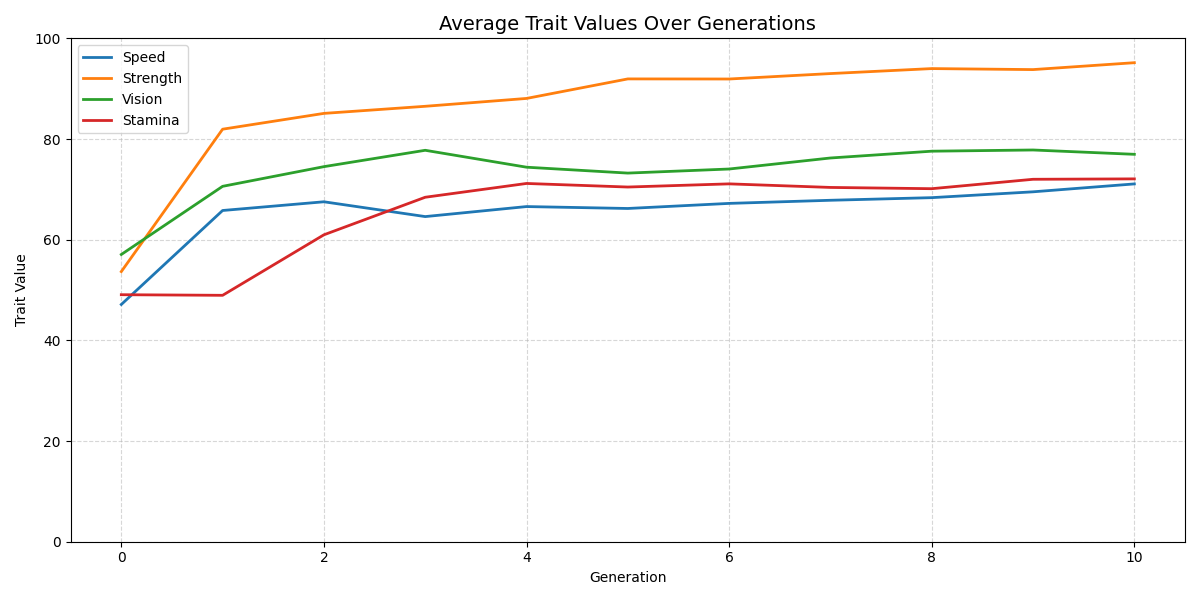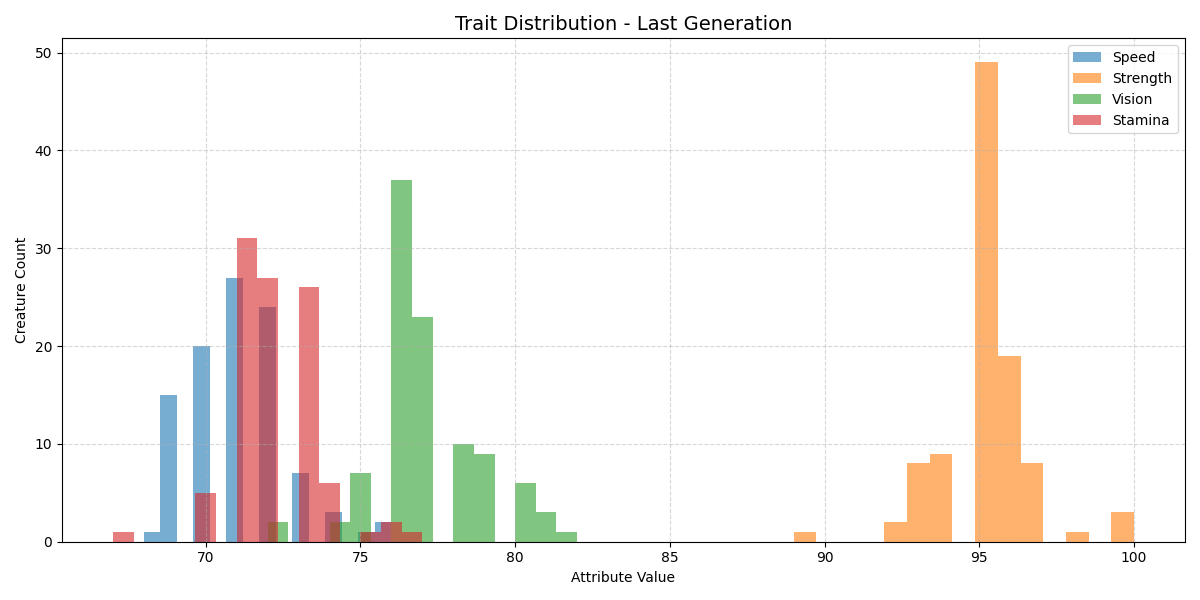PyEvolve: Genetic Algorithm Simulation
What is PyEvolve?
PyEvolve is a simple yet powerful genetic algorithm simulation that demonstrates evolutionary principles through computational modeling. The simulation creates a population of virtual creatures with various attributes (speed, strength, vision, and stamina), evolves them over multiple generations, and visualizes the results.
This project is perfect for:
- Learning about genetic algorithms and evolutionary computation
- Experimenting with different fitness functions and selection methods
- Visualizing how traits evolve over generations
- Understanding basic principles of natural selection in a computational context
🎮 Try the Demo
Want to see PyEvolve in action without setting up Python? Download our pre-compiled demo executable and run the simulation immediately!
The demo includes:
- Pre-configured simulation with optimal settings
- Automatic generation of visualization graphs
- No Python installation required
- Works on Windows systems
📥 Download Demo (Windows .exe)
Note: The demo executable is approximately 15-20MB and may trigger antivirus warnings due to being an unsigned executable. This is normal for Python-compiled executables. Don't worry it's not sketchy! Have fun reviewers! ;)
Quick Installation Guide
- Clone the repository:
git clone https://github.com/Papaya-Voldemort/Creature-Evolution-Sim.git
cd Creature-Evolution-Sim
- Install the required dependencies:
pip install -r requirements.txt
- Run the simulation:
python main.py
Example Usage
Basic Simulation
The default configuration in main.py creates a population of 100 creatures and evolves them over 10 generations:
import random
from helpers import Creature
from helpers import calculate_offspring, produce_next_generation
import matplotlib.pyplot as plt
import os
population_count = 100
population = []
generation_goal = 10
# Create initial population
for i in range(population_count):
speed = random.randint(1, 100)
strength = random.randint(1, 100)
vision = random.randint(1, 100)
stamina = random.randint(1, 100)
creature = Creature(speed, strength, vision, stamina)
population.append(creature)
# Sort by fitness
population = sorted(population, key=lambda c: c.fitness, reverse=True)
generations = [population]
# Evolve for multiple generations
for gen in range(1, generation_goal + 1):
survivors = generations[-1][:20] # top 20 from previous generation
next_generation = produce_next_generation(survivors, population_count)
next_generation = sorted(next_generation, key=lambda c: c.fitness, reverse=True)
generations.append(next_generation)
Customizing the Simulation
You can easily modify the simulation parameters:
- Change
population_count to simulate larger or smaller populations
- Adjust
generation_goal to run for more or fewer generations
- Modify the selection criteria (currently takes top 20 creatures)
- Edit the
calculate_fitness method in the Creature class to change how fitness is determined
- Adjust mutation rates in the
calculate_offspring function
Visualization Examples

Fitness trends over generations showing average, maximum, and minimum fitness values.

Evolution of average trait values (speed, strength, vision, stamina) across generations.

Distribution of trait values in the final generation.
Understanding the Code
Key Components
- Creature Class: Represents an individual with four attributes and a fitness calculation
- calculate_offspring: Creates new creatures by combining traits from parents with possible mutations
- produce_next_generation: Generates a new population from the selected survivors
Fitness Calculation
The default fitness function weights the attributes as follows:
def calculate_fitness(self):
fitness = (0.3 * self.speed) + (0.3 * self.strength) + (0.2 * self.vision) + (0.2 * self.stamina)
return fitness
Future Development
Check out the TODO.md file for planned improvements and features. Contributions are welcome!
Get Started Today!
PyEvolve is a great way to learn about genetic algorithms and evolutionary computation. Clone the repository, run the simulation, and start experimenting with your own modifications!
View on GitHub


